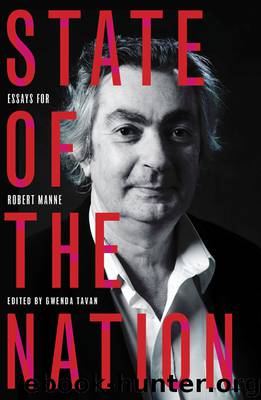State of the Nation by Gwenda Tavan

Author:Gwenda Tavan
Language: eng
Format: epub
Publisher: Black Inc.
Published: 2013-09-25T16:00:00+00:00
CONTRAST AND CONTINUITY, RESISTANCE AND ACQUIESCENCE: ROBERT MANNE AND AUSTRALIAN UNIVERSITIES
Russell Marks
Robert Manne arrived at Melbourne University in 1966 and completed a four-year BA with Honours, then left for Oxford partway through 1970. His presence on campus coincided exactly with the most radical years in the history of Australian universities, as students dragged middle-class Australia out of its postwar malaise and into the global 1960s.
In One-Dimensional Man (1964), Herbert Marcuse had complained that liberal democracies, for all their feted freedoms, were oppressive for anyone who did not share in the dreams of the heterosexual nuclear family under Christian capitalism. In some ways it feels like we’re back in a one-dimensional malaise in the early part of this century. At the end of Manne’s formal teaching association with the university system, market capitalism has become truly hegemonic. It provides the discursive framework for the discussion of almost everything, and seems to be the only ideology that has any traction at the level of government and management.
One way of presenting the recent history of Australian universities in a volume devoted to honouring Manne’s intellectual contribution to Australia is to compare and contrast the ‘slices’ that correspond to those periods at the beginning and end of Manne’s formal involvement with Australian universities: namely, the late 1960s and the early 2010s.
There have been two seismic shifts in the history of education in Australia in the last hundred years. The first was the decision by postwar governments – first Labor, then the Coalition – to coopt the universities in their pursuit of economic ends. The Keynesian ‘end’ was full employment; the means was a workforce capable of being deployed in increasingly technical and knowledge-intensive occupations. Governments made a series of conscious decisions to direct greater shares of the tax receipts from the postwar boom into expanding the education ‘sector’, as it was soon described. Until the postwar period, access to upper-secondary and tertiary education was largely restricted to the children of elite families. Governments were keen to expand this access – for high-minded democratic reasons, yes, but mainly to facilitate the modernisation of the citizenry and labour force in line with international trends.
The second seismic shift was the switch in mainstream economic thinking from Keynesian to neoliberal principles in the mid-1970s. By the second half of the 1960s, the dominant economic discourse was still Keynesian, and the incorporation of the universities by the state had until then materialised only in a creeping Commonwealth takeover from the states of the universities’ funding and governance, and in the rapid expansion of the sector’s capacity. During the decade before 1966, government spending on education more than doubled. The number of students attending Australian universities nearly doubled in just seven years, from 47,000 in 1959 to 91,000 in 1966. Student numbers would nearly double again, to over 160,000, before Robert Manne graduated at the end of 1969. The Menzies government was motivated to expand the university system by political and economic considerations: the need to counter the Soviet Union’s
Download
This site does not store any files on its server. We only index and link to content provided by other sites. Please contact the content providers to delete copyright contents if any and email us, we'll remove relevant links or contents immediately.
Becoming by Michelle Obama(9896)
Beartown by Fredrik Backman(5555)
The Last Black Unicorn by Tiffany Haddish(5530)
Man's Search for Meaning by Viktor Frankl(4363)
The Book of Joy by Dalai Lama(3862)
In a Sunburned Country by Bill Bryson(3457)
The Five People You Meet in Heaven by Mitch Albom(3440)
Full Circle by Michael Palin(3355)
The Choice by Edith Eva Eger(3290)
The Mamba Mentality by Kobe Bryant(3156)
The Social Psychology of Inequality by Unknown(2906)
Book of Life by Deborah Harkness(2841)
Imagine Me by Tahereh Mafi(2782)
The Checklist Manifesto by Atul Gawande(2746)
Less by Andrew Sean Greer(2614)
A Burst of Light by Audre Lorde(2414)
The Big Twitch by Sean Dooley(2369)
No Room for Small Dreams by Shimon Peres(2294)
No Ashes in the Fire by Darnell L Moore(2253)
